Menu
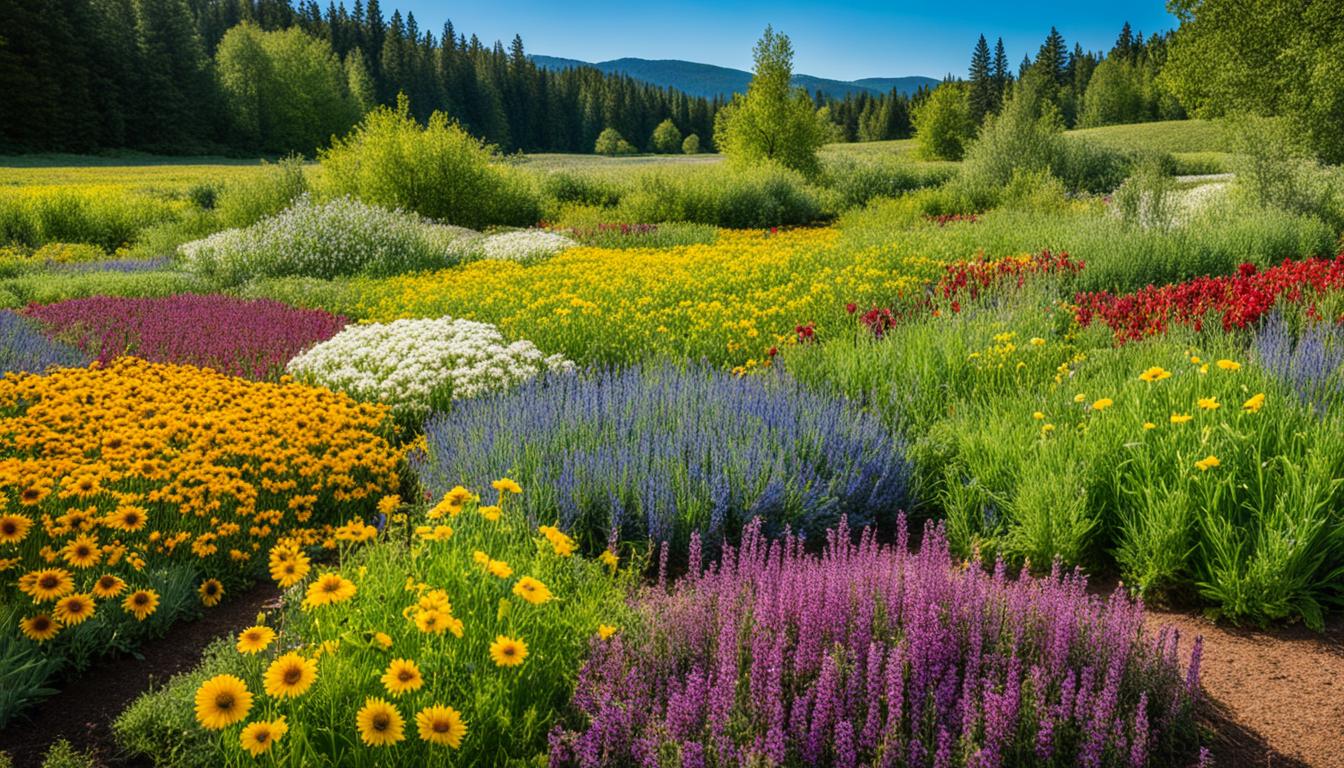
Standing in the fields, I feel a deep connection to the earth. Here, there’s an energy of life, growth, and strength. Enhancing farm biodiversity is about more than science. It’s a pledge to support nature’s harmony. This ensures every living thing, from tiny fungi to grand oaks, thrives in the life’s rich tapestry.
The earth harbours more than 8.7 million animal, plant, and fungal species. But, this wealth of life is at risk. Monarch butterfly populations have dropped by 70% in the US, mainly from habitat loss. The use of herbicides has also cut the variety of wild plants, harming soil and crop health indirectly.
To face these issues, farms need a new strategy. Studies from Agriculture and Agri-Food Canada (AAFC) highlight the benefits of varied crop rotations. This approach isn’t just good for the earth. It also boosts soil health, cuts emissions, and can increase corn yield by 28%. It proves that sustainable farming is a victory for us all.
Farmers must focus on biodiversity to make their land productive and tough against bad weather. They use agroecology techniques to keep their farms stable and thriving. This supports nature and the money they make.
Biodiversity on farms helps with pollination, fighting off pests, and making healthy soil. Different types of crops handle climate changes and pests better because of their genetic variety. Growing many kinds of food makes ecosystems stronger. This keeps our food safe and controls pests and diseases.
Looking after biodiversity helps the environment and saves money. Diverse farms produce crops more steadily and need fewer chemicals. This is good for your wallet and the planet. By using agroecology techniques like rotating crops, farms also help more plants and animals thrive.
Ordinary farming uses a lot of diesel compared to eco-friendly ways. This eco-friendliness cuts back on farming’s harmful gases a lot. For example, cover crops are being used more by farmers, which is better for the earth and local business.
Agro-biodiversity means there’s a wide range of plants, animals, and tiny organisms important for food and farming. It covers the differences within species, the number of species, and the types on Earth. Everything from the soil’s tiny life to different crops and animal types play a big part in farming.
Since the 1900s, 75% of plant genetic diversity has been lost. This was because farmers started using mostly the same type of high-yield crops. This loss makes farming weaker against diseases, pests, and changes in weather. Important terms in agro-biodiversity are:
Currently, 75% of our food comes from only a few plant and animal kinds. Such few sources show that we need more diversity in agro-biodiversity. It’s vital for reliable and sustainable food and farming.
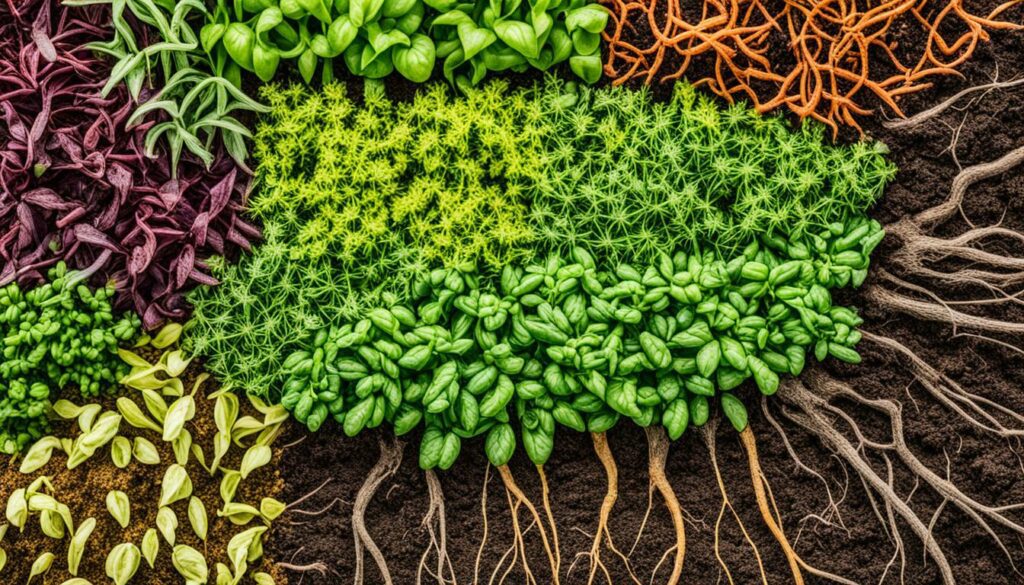
Various farming methods are already using agro-biodiversity well. For example, using different crops in rotation can make the soil healthier. This is done by adding more nutrients and organic material to the soil.
Here are some real examples:
| Farming System | Practice | Benefits |
|---|---|---|
| Indigenous Intercropping | Growing multiple crops in the same space simultaneously | Enhances soil fertility, reduces pest outbreaks, and boosts yields |
| Conservation Agriculture | Minimising soil disturbance, maintaining cover crops, and diversifying plant species | Improves soil structure, conserves water, and increases organic matter |
| Agroforestry | Integrating trees and shrubs with crops and livestock | Enhances biodiversity, provides habitat for wildlife, and stabilises ecosystems |
The destruction of forests and other natural lands speeds up agro-biodiversity loss. So, farming methods that keep agro-biodiversity strong are key. They help feed the world’s growing population while keeping nature’s balance.
“Biodiverse farms are more able to deal with diseases, pests, and other challenges. Ways of farming that mix different crops, like those used by farmers everywhere, are essential for a lasting future in farming.”
Fostering soil health is key to successful farming, especially the rich life under our feet. Prokaryotes, or bacteria, show a huge variety, around 9,000 species in a square meter. With each species totalling about 200 trillion, they are essential for healthy soil and strong plant growth.
Beyond bacteria, the soil also teems with fungi, with about 200 million species in a square meter. Mycorrhizal fungi shine through with 208,000 species each square meter. They are vital in recycling nutrients and helping plants withstand tough times. This fungal diversity is key for fertile and resilient soil.
Organic farming boosts these numbers, protecting and growing various soil life. Protists are among the quiet heroes, with 1,200 species in a square meter and about 10 million of them. They balance out the soil microbes and nutrients, keeping the soil’s health in check.
Another important soil helper are nematodes, tiny worms that number around 100 species per square meter. With a healthy 9 million of them, they help recycle nutrients through decomposition.
Earthworms are known signs of good soil, with about 15 species in a square meter. They can number up to 300 individuals. They churn the soil, making it airy, well-structured, and good at absorbing water. This is great for farming that looks to the future.
Encouraging a variety of life in the dirt through smart farming helps increase the soil’s health and its ability to use and keep nutrients. This makes for rich, strong soil that supports growing crops well. Techniques like changing what you grow in each field and not digging a lot are key.
The work the soil life does is really valuable. The FAO says it’s worth more than $1542 billion to society. This shows how important it is to keep the soil’s life diverse. This is critical for the future of farming and our food.
In today’s farming, crop rotation is very important. It helps crops stay healthy. By changing the crops each year, farmers can make their land stronger and produce more. This makes their farms more sustainable.
Farms pick different crop rotations based on their needs. Some common rotations are:
Diverse crops are good for the land and the farmer. They bring many benefits:
| Benefit | Description |
|---|---|
| Improved Soil Structure | Plants with diverse root systems make the soil better. They hold more water and stop it from washing away. |
| Enhanced Biodiversity | Using different crops means more life on the farm. This is good for the environment. |
| Reduced Chemical Use | Growing different crops together needs fewer chemicals. This means the farm is healthier. |
| Carbon Sequestration | When farmers rotate crops and don’t plough too much, they help fight climate change by trapping carbon in the soil. |

The Agriculture and Agri-Food Canada (AAFC) has done a lot of research on crop rotation. Their work shows that over the years, using different crops has big benefits. It lowers the need for artificial inputs and makes the soil better. This is great for keeping a farm productive for a long time.
Long studies show that rotating crops helps the environment and the soil. Adding crops like alfalfa and small grains can make the soil healthier. It also helps the soil deal with lack of rain.
By using crop rotation, farmers can do good for the earth and their farms. It’s a way to farm that is good for the environment and keeps the land healthy.
Intercropping is an important tool that helps farmers grow more with less. It’s all about planting two or more crops near each other. This approach boosts how much we can grow on the same plot of land. It also helps the environment, making farming more friendly to wildlife.
Indigenous people have known about intercropping for a long time. They used it in ways that helped their crops thrive. For example, some Native American tribes planted corn, beans, and squash together.
This trio of crops worked together. Beans added nutrients to the soil. This helped the corn grow. Meanwhile, squash spread across the ground, keeping weeds away and keeping the soil moist.
Today, with new farming techniques, we’re rediscovering the value of intercropping. Studies have shown that combining crops can save up to 23% of the land. This approach is better for the soil and means farmers don’t have to use as many chemicals.
In Western Canada, research has shown the benefits of intercropping. Although it may slightly reduce the amount of grain and calories produced, it can often lead to similar or better protein yields. When farmers use less nitrogen fertiliser, intercropping can produce an extra 1.5 tons of grain per hectare on average.
Researchers use a term called the land equivalent ratio (LER) to measure intercropping’s effectiveness. An LER over one means it’s better than planting a single crop. For grain and protein yields, the LER is 1.23. This means intercropping does better than planting one crop alone. It shows how intercropping is a winner, boosting both productivity and resilience of farms today.
| Benefits | Intercropping | Sole Cropping |
|---|---|---|
| Land Savings | 18-23% | 0% |
| Mean Effect Size (Grain Yield) | 1.23 | 1.00 |
| Mean Effect Size (Protein Yield) | 1.23 | 1.00 |
| Additional Grain Yield per Hectare | 1.5 tons | 0 tons |
Understanding *sustainable farming practices* shows us their key role in making the environment healthier. These methods take a wider view of farming. They aim for both long-lasting farm output and keeping the environment safe.
The key ideas in sustainable farming are about saving resources and keeping a balance in nature. One big part is growing different types of crops. This way, the risk of pests is lower and the farms can handle changes in the weather.
Research finds that farmers with around 20 to 350 acres do this best. This is because they own their land and can get money easier.
There are green ways to boost the variety of life on farms. One way is to grow different crops close to each other. This is called intercropping. It helps the different plants help each other out.
Organic farming is also key. It uses natural ways and avoids harmful chemicals. This keeps the land and water safer.
| Farm Type | Size Range | Sustainable Practices |
|---|---|---|
| Limited Resource Farmers | 1-20 acres | Need policies addressing limitations in time, money, and social capital |
| Mid-Scale Farmers | 20-350 acres | Adopt diversified crops with secure land tenure and access to resources |
| Wholesale Growers | > 500 acres | Require assistance in negotiating supply chain demands and alternative markets |
Many studies show that new ways of farming can greatly increase how many different plants and animals live on a farm. For example, planned changes to help more species and stopping the use of some pesticides work well. A big study looking at lots of others also confirmed these good effects.
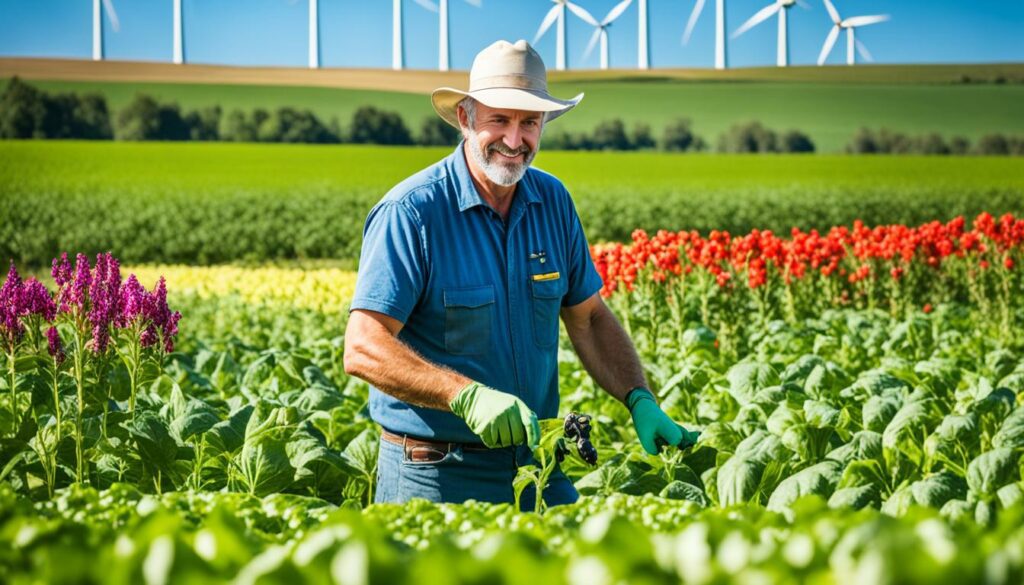
So, growing different crops, planting them close together, and using natural farming are important for both sustainable farming and having lots of different life. These methods help the environment and make farms stronger and more able to keep going.
Cover crops are a key part of today’s sustainable farming methods. They improve soil nutrients and help to protect our land for the future. By growing cover crops, farmers can boost soil health and make their farms more productive.
There are two main types of cover crops: legumes and non-legumes. Legumes like clover and alfalfa can take nitrogen from the air and put it in the soil. They help future crops by giving them 50-150 pounds of nitrogen per acre.
Rye and oats, as non-legumes, help by taking up extra nitrogen. When they are planted in the fall, they can use 30-50 pounds of nitrogen per acre.
Cover crop mixtures, known as “cocktails,” can do even more. By mixing different types, you can get more plants and nitrogen. This is good for soil and means farmers need less chemical fertilisers.
Growing cover crops is becoming more common. In 2017, farmers planted them on 15.4 million acres, which was a 50% jump in five years. Some states have more than doubled their cover crop use.
There’s proof that cover crops help crops more than just in a dry spell. In 2012, a year of drought, farmers saw more corn and soybeans because of cover crops. Using them over five years, you can get 3% more corn and 4.9% more soybeans.
If animals graze on cover crops, it’s even better for the farm. Their manure adds to the soil and makes it healthier. At the same time, cover crops protect the land, keep it diverse, and make farms tougher against problems.
Cover crops not only help with soil but also support healthy farming. They’re a key part of good farming today, safeguarding the future of our food.
Making farms more diverse helps crops fight off many problems. By using smart farming methods, farmers can increase biodiversity. This leads to healthier crops. Studies show that farms with a lot of variety are better at handling bad weather and pests.
Research from 331 studies finds that ‘green’ farming helps more than ‘old’ ways. This includes using cover crops or letting wild plants grow. These methods naturally protect the farm. Fertilisation, varied crops, and soil protection are also important. For example, making field edges at least two metres wide helps many animals and plants.
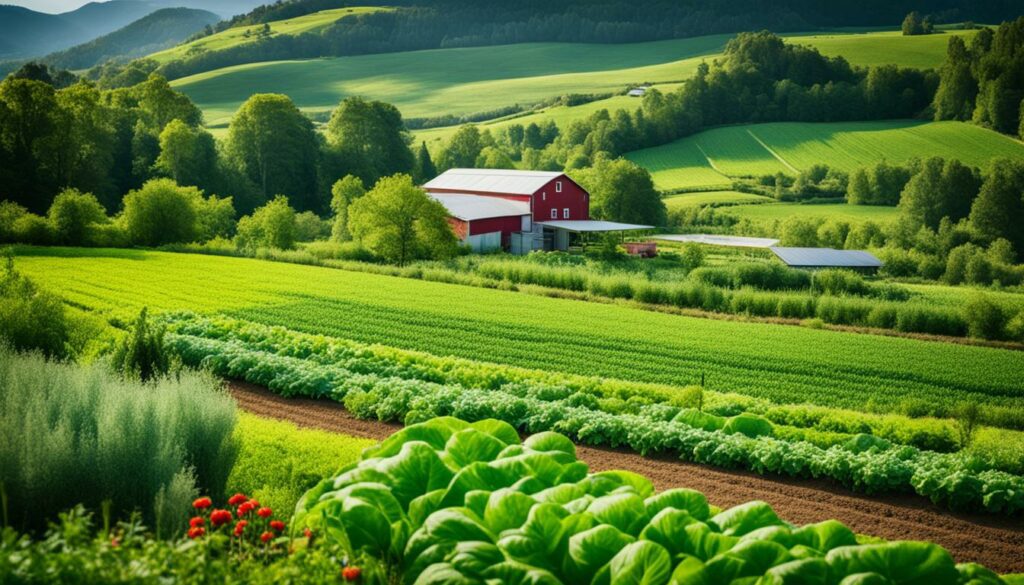
It’s also good to have parts of the farm that are chemical-free. 35 different green farming ways have been found to help wildlife. Planting various grasses and creating nettle areas can draw in helpful insects and birds. This is important for keeping the ecosystem healthy.
Farmers of different sizes face unique challenges and need different help. Small farmers need help with land and water. Medium farmers often have better access to resources, which helps their business. But, they also need support to find the right buyers. Large farmers struggle with high costs and market pressures, making it hard for them to diversify.
Programs like California’s Healthy Soils are good but are not used much across the country. We need to do more to help farmers grow different things. Making good markets for their products can help. This will reduce the influence buyers and profit squeeze.
By improving farm biodiversity, we make our crops and landscapes stronger. This prepares agriculture for future challenges, ensuring a more sustainable tomorrow.
| Farm Scale | Challenges | Solutions |
|---|---|---|
| Small-scale (1-20 acres) | Land tenure, water access | Secure land tenure, increase technical assistance |
| Mid-scale (20-350 acres) | Access to capital, resource distribution | Facilitate relationships with value-aligned buyers |
| Large-scale (350+ acres) | Market pressures, high land values | Create alternative markets valuing diversity |
Taking steps like planting diverse grasses and protecting field borders helps both biodiversity and crop health. This makes farms stronger. By learning from many studies and using good farming methods, we see that biodiversity is key to a sustainable future in agriculture.
Farming in a way that helps both crops and wildlife is crucial. This approach boosts the richness of life on farms. It makes farms more productive and better for the environment.
Planting “hedgerows” around fields helps birds and insects. These natural barriers provide homes for them. Studies show organic farms have 70% more types of plants. This shows their positive effect on nature.
Some studies thought wild areas could spread disease. But the University of California showed this isn’t true. They found wildlife-friendly farms can be safe for food. Cambridge University also found such farms help crops, soil, and the ecosystem. Yet, we don’t know everything about these methods.
Experts suggest setting clear rules for eco-friendly farming. Farms with clear eco-goals do better for butterflies. This is great for the whole environment.
Diverse farms help tackle the loss of species worldwide. For example, a single farm can be home to thousands of insects. Birds feed on these insects, ensuring both insect and bird populations thrive. This makes farming more sustainable in the long run.
| Farming Practice | Habitat Diversity Increase | Species Richness (Butterflies) | Species Richness (Plants) |
|---|---|---|---|
| Conservation Grade (CG) | 25% higher at 100m radius | Significant increase | Moderate increase |
| Organic Farming | 70% higher | 50% higher | 70% higher |
| Entry Level Stewardship (ELS) | Baseline | Baseline | Baseline |
Organic farming is more than just popular; it’s key to farming sustainably. It helps with soil health and the variety of life in an area. By going organic, farmers increase the nutrients in the soil and grow better crops. This article will explore how these methods impact farming.
Organic farming uses many methods to boost soil health, leading to more life. Research shows organic soil keeps lots more carbon than regular soil. Why is this a big deal? Because most of the world’s carbon is in the ground, making it super important for the environment.
Cover crops are vital in organic farming. They stop weeds and feed the soil well. A big review of 153 studies found that adding things like compost helps the soil store more carbon. The best results come when farmers mix different organic types together.
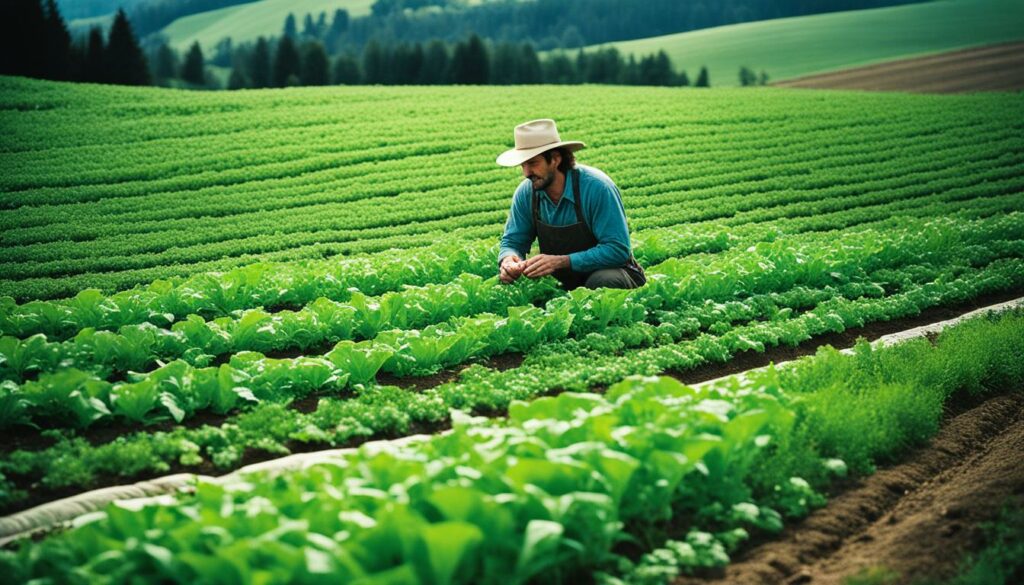
Organic farming really changes the game for the soil. Over time, human farming has lost a lot of carbon from the soil. But organic methods add this carbon back, making soil healthier and more fruitful. This leads to nicer crops because the soil is full of the good stuff plants need.
As the organic market grows, it shows that people and farmers see the benefits. Better soil and more life are at the heart of these practices. This proves that investing in organic ways is really investing in a healthier future for the planet.
Agroforestry is a farming method that combines trees or shrubs with crops and livestock. This approach offers many advantages, both for the environment and the economy. It helps make farms more diverse and boosts their ability to bounce back from challenges.
Agroforestry mixes trees, shrubs, and crops deliberately, enhancing the farm’s ecosystem. This strategy makes the farm habitat more diverse and resilient. In Colombia, agroforestry has shown significant benefits for wildlife over ten years, proving its success over time.
This method is also key in stopping soil erosion in places like Colombia and Ghana. These areas rely on mountains for coffee and cocoa but face the risk of soil loss. Trees help keep these soils steady, which is vital for long-term farming there.
Agroforestry is great for the environment as it helps gather carbon from the air. This aids in fighting climate change. By using agroforestry, soil becomes richer, making it better for planting and growing food.
It also makes sense economically. Farmers can earn from selling timber, fruits, and more, not just from their main crop. Some practices can even earn money from helping the environment. Plus, agroforestry creates jobs in making tree nurseries, raising fish, and keeping bees.
| Cost of Environmental Degradation | Mitigation via NBS | Annual Impact by 2050 (USD) |
|---|---|---|
| Coastal Zone Degradation | Agroforestry and Regenerative Ag | $327 Billion |
| Loss of Carbon Storage | Eco-friendly Practices | $128 Billion |
| Loss of Pollinators | Diverse Agroforestry Systems | $15 Billion |
| Water Availability for Agriculture | Water-preserving Agroforestry | $19 Billion |
| Loss of Forest Services | Integrated Land Use | $7.5 Billion |
The United Nations is urging more investment in agroforestry and other Nature-Based Solutions. They say it could save a lot of money in fighting environmental damage. This approach is crucial for both the economy and the environment.
To sum up, agroforestry boosts farm biodiversity and income. It creates a more resilient farming system for the future. By adopting agroforestry, we ensure a sustainable food supply for all.
Many case studies help us see how to manage biodiversity on farms well. These studies show the best things to do and what we can learn. They help farmers get both money and help the environment. And they give real tips for farmers all over the world.
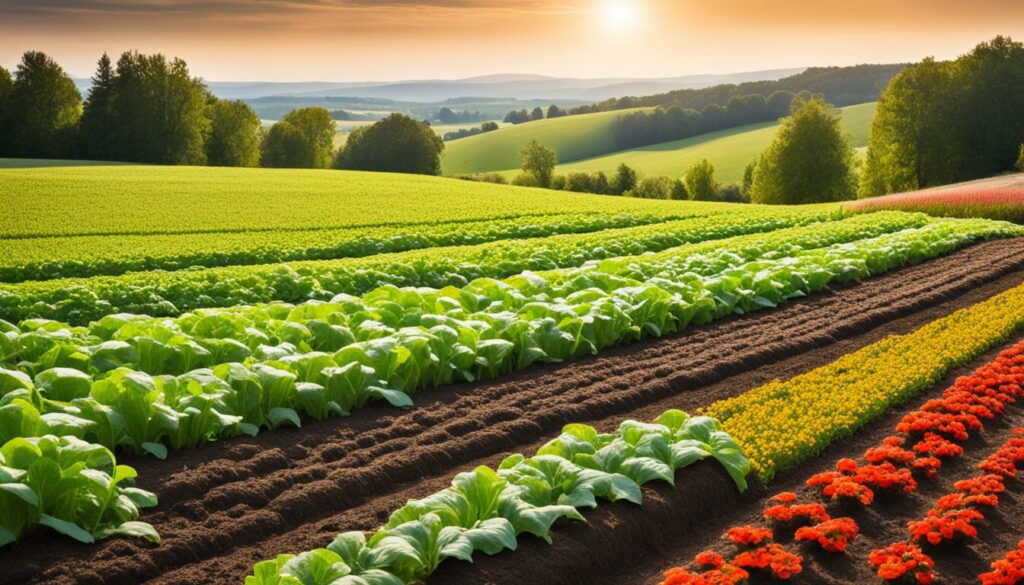
Canada leads with lots of studies on protecting farm biodiversity. They show how things like the Biodiversity of Mycorrhizal Fungi and Worm Watch help soil and crops be healthier. For example, in Western Canada, growing different crops together helps them produce more and stay strong.
In the US, places like Freight Farms show we can grow many types of food without harming nature much. This is done by farming vertically. In Canada, QuantoTech teams up with places like Mackenzie to make fresh vegetables always available. This helps the local economy and the environment.
North America’s case studies teach us important things about keeping biodiversity on farms. Mexico shows us that small coffee farms need a lot of help and learning. This tells us we need good ways to teach and support farmers. Also, in southern Africa, farming with native fruit trees shows farming can be good for people and the land even in dry areas.
Not far from Mexico’s Calakmul Biosphere Reserve, smart farming helps a lot. By growing food in a good way near natural forests, farms do better and nature is safer. In China, eco-farming shows us how to use nature in a smart way. These ways can work everywhere in the world.
“The multiplier effect of combining various biodiversity-enhancing practices, such as cover crops and ecological farming methods, cannot be overstated. The sustainability and resilience observed through these case studies provide a robust roadmap for global agricultural development.” – FAO
Finally, FAO is doing a lot to teach and connect farms all around the world. Their work shows that working together is the best way to keep biodiversity safe on farms.
| Country | Case Study Focus |
|---|---|
| Canada | Biodiversity of Mycorrhizal Fungi, Worm Watch, Pollination studies |
| Mexico | Organic coffee production, Agroforestry management |
| China | Eco-Farming and sustainable use of agricultural biodiversity |
| India | Azobacter and biological resources on agrobiodiversity |
| Southern Africa | Indigenous fruit trees for economic and environmental sustainability |
| United States | Vertical agriculture in remote and urban areas |
We’ve looked deeply into how farm biodiversity matters. It’s not just key for sustainable farming – it’s necessary. After examining many studies, it’s clear that certain farm methods really help biodiversity. These include using different crops, adding more plants in between them, and avoiding pesticides.
Though one method may not help all types of wildlife, most see benefits. Adding more plants mainly helps those living in the open. However, using less pesticides is good for almost all species.
With a lot of land used for farming, it’s vital to keep nature thriving. Agroecology, like changing crops seasonally and going organic, can help a lot. These methods reduce harm from intense farming.
To make farms more stable in the future, we must protect nature. This is important for farming to work well and for many creatures that depend on diverse regions. Continuing efforts to improve biodiversity in farming is key for a healthy planet.
Farm biodiversity is key in making crops healthy. It helps keep a balance in nature. This means crops are safer from pests and diseases. Mixing different crops helps the soil stay healthy. It also means crops can cope better with bad weather, getting higher yields.
Biodiversity helps farms in many ways. It creates a system where different plants and animals help each other. This makes farms stronger against things like bad weather. Biodiversity also helps control pests, pollinates plants, and recycles nutrients.
Farm biodiversity has good results for business and the environment. It boosts crop growth and cuts costs. It also helps open up new markets. For the planet, it means healthier soil, fewer harmful gases, and more living space for wildlife. This all makes farming more sustainable.
Agro-biodiversity is the many different plants, animals, and tiny life forms we use in farming. It’s important because it makes nature work for us. It helps with job like making sure crops grow well, keeping pests in check, and recycling nutrients. These are key to the success of farming.
Different farms use varied ways to add agro-biodiversity. They mix crops, growing different ones together. They also include traditional farming methods. These ways copy the rich variety of nature. This helps keep the soil healthy and makes crops more robust.
More types of plants and animals mean healthier soil. They help add good stuff to the soil, keep nutrients moving, and make it more alive. Long-term, this means the soil stays good for growing crops, making the farm stronger and more stable.
There are simple and complex ways to rotate crops. All kinds improve the soil and fight off pests. They can also make sure there are crops to harvest each year. Using different crops in turns means the soil stays rich and healthy over time.
Intercropping helps by using the land more efficiently. It mixes crops that don’t compete for the same nutrients. This can mean better soil and less need to use chemicals. It also tends to make the farm more productive overall.
Good farming for the long term means having many kinds of crops, looking after the soil, using less bad chemicals, and choosing earth-friendly ways. These steps keep the farm strong and working well. They ensure it stays healthy for a long time.
Plants like legumes, grasses, and brassicas are good for covering the soil. They make the soil richer, help it hold water, and keep pests away. This makes the whole ground where crops grow a better place for farming.
Farms can help good bugs and animals by making homes for them. This can include growing hedges, leaving wild plants, setting up places for birds to nest, and protecting natural areas. These acts make the farm friendlier to these helpers, meaning better crops.
Going organic boosts the ground and its wildlife. By not using artificial tricks and working with nature, the soil gets filled with good nutrients and life. This leads to crops growing well without harm, making for even better food and a richer environment.
Agroforestry means mixing trees and bushes with regular farming. It adds more life forms and activities, making the farm more vivid. It also brings more money from different products and uses the land better. This way, farming becomes more diverse and interesting.
Yes, places like Canada and North America show that mixing crops, adding trees, and using the land well works. These cases highlight the real benefits of caring for nature on the farm. They prove it’s not only good for the earth but for business too.